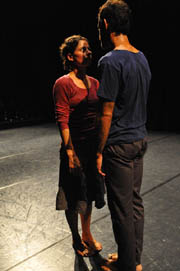
Jack Anderson
Pas de Trois: Cardona, Vonmoos, Kierkegaard
"A Light Conversation"
Wally Cardona and Rahel Vonmoos
Joyce SoHo, 155 Mercer Street, SoHo
January 7-12, 2010, 8 p.m., except January 10 at 3 p.m., $18
Tickets: (212) 352-3101 or www.joyce.org
Reviewed by Jack Anderson, January 12, 2010
| A LIGHT CONVERSATION -- Photo by Heinz Peter Knes. |
When was the last time you attended a dance performance for which the accompaniment was a discussion of the life and teachings of Søren Kierkegaard? For that matter, have you ever attended any dance performance to a text by that 19th-century Danish philosopher? Wally Cardona and Rahel Vonmoos created just such a dance with their collaboratively choreographed duet, "A Light Conversation," and it turned out to be neither intellectually inscrutable nor theatrically dreary.
Quite a lot happened in slightly less than an hour. The dancers had modified the theater's seating arrangement so that spectators sat on three sides of the performance area, changing the space from a proscenium stage into a sort of arena that put the dancers on display in our midst as they moved to a recorded BBC panel show devoted to Kierkegaard. In this arena setting, every move invited intense scrutiny.
Cardona, bearded and sturdy-looking, was a strong presence, while Vonmoos often seemed shyer and more tentative, yet her concentration never flagged. Each appeared intensely aware of the other's presence, even when not facing each other. Many twists, turns, and little runs usually made it seem as if these people were talking to, or questioning, each other. But sometimes they could have been talking to themselves in each other's presence.
 |
| Photo by Christian Glaus. |
The BBC panelists emphasized that because Kierkegaard could be both a questioning philosopher and an ironical one, you can never be sure how much to believe him. The dancers often met, as if in agreement, yet when they hung on to each other, it was difficult to determine if their clinging represented concord or desperation. They could also appear to be lost in realms of their own, as when Vonmoos paced along the rim of the space, staring at audience members as if seeking advice from them. The entire dance was often a sharing of uncertainty, which was quite appropriate for Kierkegaard's musings on love, freedom, occasions when "reason is redundant," and realizations that "we're always in the process of becoming."
Whereas Kierkegaard talked about it, Cardona and Vonmoos made that process
visible. At one point when Kierkegaard was quoted as agreeing with the biblical
injunction to "love your neighbor," Cardona held and kissed Vonmoos,
and when Kierkegaard went on to declare that "your neighbor includes
your enemy," the dancers fiercely embraced. Although there were a lot
of words by Kierkegaard and his BBC interpreters, who pronounced him a father
of existentialist philosophy, the dancers never uttered a word. Instead, they
let their bodies do the talking and, as they moved, they took us along with
them from one existential encounter to another.
| museums | NYTW mail | recordings | coupons | publications | classified |
